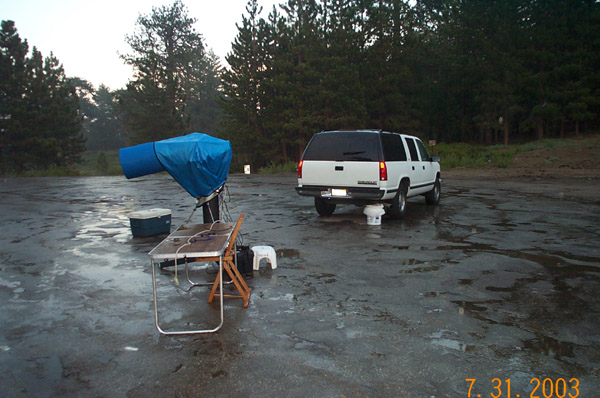
Frog (and friend)
There
were a few orographic cumulus clouds hanging around
the summit of Mount Pinos as I set up my gear for a
few nights of imaging. "Nothing to worry about" I said to myself,
"they'll dissipate by nightfall and I'll enjoy a night of clear, dark
skies. Following a monthly ritual, I spent the next two hours setting up the
equipment I use for astronomical imaging. Trying to ignore the fact that the
clouds were overtaking the last vestiges of blue sky, I was beginning to
question the wisdom of setting up all this expensive equipment under a sky
rapidly filling with clouds. Now it was time to set up the laptop, the electric
focuser, the power inverter and the camera's power supply, plus what seems like
hundreds of wires, cords and cables. This stuff doesn't like water. What if it
rains?
Should
I continue? Should I pack up? Should I just wait and see?
Unwilling
to steal defeat from the jaws of victory, I decided to leave the remaining
equipment in my vehicle and watch the weather for a while. I poured myself a
glass of Cabernet Sauvignon, sat in the Suburban and listened to the radio as
the Phillies gave the Dodgers a lesson in baseball. And the sky grew darker and
darker. Another sip of wine and I heard a distant clap of thunder. Damn!
Within
two minutes the scope was wearing a protective cape of aluminized mylar, ready for rain should it come. The C11 and my new AstroPhysics mount would stay dry. As I returned to the
truck, the first drops fell. For 45 minutes it rained, quite hard at times.
By
7:30 the rain subsided and the sky cleared quickly. "Ha", I thought
to myself, "Good call!" I hurriedly set up the remaining gear and
polar aligned the mount, working around a few wisps of lingering clouds. By
10:30 I was ready to begin the first exposure sequence. The dark nebula I would
shoot all night was properly framed, and the autoguider
was calibrated and tracking. In the computer software that runs the CCD camera,
I set up a sequence of twenty-one red-filtered exposures of ten minutes each.
Three and a half hours of red-filtered exposures would be used for the
luminance channel in the final RRGB image. This dark nebula is seen in
silhouette against a red emission background, so a red-filtered luminance
channel would work well. Despite the heavy condensation that kept even the
laptop's screen and keyboard damp, I was happy I'd chosen to stay through the
rains. It was going to be a good night.
Another
bit of wine and a half sandwich later I realized the laptop was plaintively
beeping at me. Uh oh, had moisture found its way into the laptop's interior? A
quick look at the guider's image showed no guide star. Only noise. Not good!
Then, that sinking feeling came over me. I didn't want to look up, for fear of
what I'd see. Yes, the clouds were back. At first, just a little patch nicely
located in front of my target. Within twenty minutes they covered the whole
sky. They looked thick and threatening. I recalled my dear friend Helmut Wilck telling me, "If a dog bites you once, shame on
the dog. If he bites you twice, shame on you." I knew what I had to do.
It
was 3:00AM when I rolled out of the parking lot at Mt. Pinos,
leaded for home. "At least I'll beat the Friday morning rush-hour
traffic" I thought to myself, trying hard to find anything to be happy
about. I returned home with a truckload of damp astronomy equipment and fifty
minutes worth of exposures on the laptop's hard drive. Not even enough data to
get a decent monochromatic shot, much less the tricolor image I'd hoped for.
Determined
to document this stormy night's efforts, I processed the little bit of image
data and put the result here. It will help me remember the night it rained cats
and frogs.
.
- Telescope:
C11 at f/6
- AP900GTO
German Equatorial Mount
- Santa
Barbara Instrument Group ST-8E NABG CCD camera (1530 x 1020 pixels, 9 x 9mm, monochromatic, 16 bit, 13.8 x 9.2mm array)
- CWF8
color filter wheel with Ha and IR-blocking red, green and blue dichroic filters
Exposure Information
- Date:
Thursday July 31, 2003
- Location:
Mt. Pinos, CA
- Elevation:
Approx. 8300', OAT +45F. RH=95% condensing
- CCD
operating temperature: -22C
- Composition:
red filtered, 50 minutes
- All
subexposures were 10 minutes, unbinned
About
This Image
I'm
sure you seasoned astronomers instantly recognized this dark nebula. For any
that need help with the identification, I'll post it here in a week or two.
About
This Outing
It
was wet!
